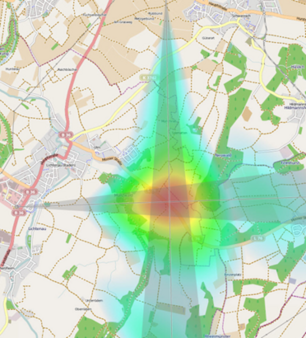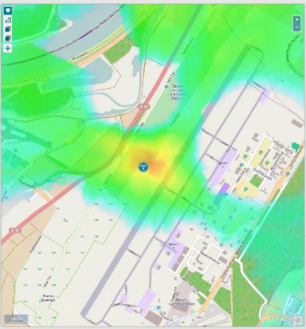Having identified a suspicious signal via spectrum scan might be a first successful step in your monitoring activities, especially if this detection can be realized “in the air” via the AMU. In many situations, you also want to determine where the signal is coming from.
With the AMU we offer, like with other remote control units of the LS OBSERVER family, the possibility of Direction Finding and even Geolocation. The standard way is based on the Angle of Arrival method, which is used by the AMU to determine line of bearings as direction finding application. For this measurement, the drone is equipped with a directional antenna and has to complete a 360° rotation on its axis. A triangulation via overlay of sequential DF measurements can then enable the geolocalisation of an emitter.
The implemented algorithm combines multiple lines of bearing to a heatmap which visualizes the statistical location approximation i.e. indicates the most likely transmitter location.
In some situations it might be of interest to benefit, as alternative to AoA, from the Gain ratio of arrival (GROA+®) method which calculates the emitter location based on power differences of a searched signal measured at three or more different locations.
The geolocation accuracy depends on precise wave propagation calculation considering topographic data. Through detailed maps and intelligent algorithms, LS OBSERVER makes GROA+® to a very precise method for geolocation.
Moreover, comparing to a fixed station and considering the AMU height, the impact of the obstacles between the AMU and the emitter is reduced, which increases the calculation accuracy.
For this measurement, the drone is equipped with an omnidirectional antenna (no need to complete a 360° rotation on its axis). In consequence, one measurement can be done very quickly.
The geolocation is achieved by sequential measurements of the AMU. This calculation can be performed based on recorded/historical data.

